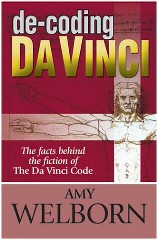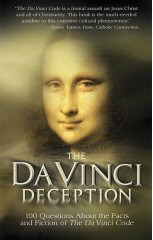|
Back to the April 2006 Newsletter Index Book Review (For printable copy of this click here) DECEPTION AND DE-CODING DEBUNK DA VINCI CODEBy Diane Levero The Da Vinci Code, with the help of an intense marketing campaign by its publisher, Doubleday, is the center of a mighty media “buzz.” Everybody’s reading it, or at least has heard about it and is wondering what all the buzz is about. The movie based on this mega-best seller is set to be released on May 19. Directed by Ron Howard, with a star-studded cast headed by Oscar winner Tom Hanks, the film is bound to be a box office smash. With 35 million copies in print, the book’s baleful influence on the public perception of Jesus Christ and the Catholic Church is already incalculable. Once the movie hits the theaters, the damage done by author Dan Brown’s skewed portrayal of Our Lord and His Church will doubtless be multiplied. You may ask, why worry about it – after all, The Da Vinci Code is only fiction. Why not just relax and enjoy it on that level?
Art, music, books and films all have an impact – sometimes a tremendous one – on our culture (ever heard of Karl Marx’s Communist Manifesto?). Secondly, this book wants to have it both ways. It’s supposedly fiction, but in the front of his book, Brown presents a list of “facts” contained in his novel. “All descriptions of artwork, architecture, documents and secret rituals in this novel are accurate,” he states. Throughout Da Vinci Code, Brown’s two scholarly characters, Langdon and Teabing, spout their assertions using phrases such as, “Historians marvel that . . .” and “Fortunately for historians . . .” and “Many scholars claim . . .” The problem is that what are passed off as historical facts are actually a pile of distortions, half-truths, and outright lies. And they are all arranged to lead the reader to the conclusion that the Catholic Church has for two millenniums ruthlessly suppressed the shocking “truth” about Jesus Christ.
Both De-coding Da Vinci and The Da Vinci Deception do a thorough job of exposing the fatal flaws in Da Vinci Code. Both are “quick reads” (they are 124 pages and 130 pages respectively). Welborn’s style is somewhat more folksy, and she relies more heavily on Protestant scholars that does Deception; she has a more inclusive, “Christian” perspective. I believe she is trying to reach a wider – both Catholic and Protestant – audience. The Deception authors, Mark Shea, Edward Sri, S.T.D., and the Editors of Catholic Exchange, argue almost exclusively from a Catholic perspective, engaging in some deep theological discussions when refuting some of Brown’s underlying assertions about the Catholic faith. Don’t get frightened off, though: Deception, presented in question-and-answer form, is very readable. If you are among the ignorant and unwashed who haven’t yet read Da Vinci Code, here’s the plot in a nutshell: Robert Langdon, a Harvard professor of “religious symbology” (there is no such field) is called to the scene of a murder at the Louvre in Paris. There he finds the body of curator Jacques Sauniere, a renowned expert on goddess worship and the “sacred feminine.” Before he died, Sauniere managed to arrange himself on the floor to look like The Vitruvian Man, Leonardo Da Vinci’s famous drawing of a man, limbs extended, within a circle. He also planted other clues, drawn in his own blood, on his body. Sophie Neveu, Sauniere’s granddaughter and a cryptologist, also called to the scene, is able to interpret the clues her grandfather has left. Langdon and Sophie work to discover Sauniere’s secret, and eventually learn that he was a Grand Master of the Priory of Sion. This mysterious group has for centuries guarded the truth which the Catholic Church suppressed: that Jesus preached a message of peace and love in which spirituality was balanced between the masculine and the feminine, and goddesses and the power of women were revered. To personify this message, Jesus married Mary Magdalene. At the time of His crucifixion (there was no Resurrection), she was pregnant with his child, a daughter. She fled to France. From her child and its offspring came France’s Merovingian dynasty (of which Sophie and her grandfather are descendants). Jesus had entrusted His movement to Mary Magdalene, but the jealous apostle Peter took it over instead. Since then, the Vatican has successfully suppressed the truth by any means, including murder (there’s an albino “monk” from Opus Dei who skulks about, trying to kill everyone). Da Vinci Code, of course, gets its name from Leonardo Da Vinci. Brown claims in the novel that Leonardo, himself a Grand Master of the Priory of Sion, had planted clues about “the truth” in his paintings. In The Last Supper, says Brown, the smooth-faced person to Jesus’ right is not the youthful apostle John, as we have always assumed, but Jesus’ wife, Mary Magdalene. Most importantly, the fact that there is no central chalice (Holy Grail) in the picture was allegedly Da Vinci’s way of indicating that the Holy Grail was not a chalice which held Jesus’ sacred blood, but Mary Magdalene herself, the “chalice” which held Jesus’ blood in the form of His child! Da Vinci Deception charges that Brown wants to achieve two goals through his book: the destruction of the Gospel and the glorification of paganism. “To intimidate,” explains Deception, “few things work as well as making the reader feel ignorant. “And so we see Langdon and Teabing continually delivering lectures to a wide-eyed Sophie who (like the reader) exclaims, ‘What? I had no idea!’ as each alleged ‘revelation’ is unfolded.” The two constantly reiterate the mantra that “scholars have known all this for ages.” To make sure no dull-witted reader misses the point, Brown has the patronizing Teabing say, “What I mean is that almost everything our fathers taught us about Christ is false.” The specious historical “facts” propping up Brown’s story are by no means original. Welborn groups them into three categories: 1.Holy Blood, Holy Grail, by Michael Baigent, Richard Leigh and Henry Lincoln, The Templar Revelation and other pseudo-history books. The Jesus-Mary Magdalene-Holy Grail-Priory of Sion element in Da Vinci Code came from these two books. 2.The “sacred feminine” school of thought, embodied in several books of fiction by Margaret Starbird, especially The Woman with the Alabaster Jar, which Brown relied on heavily for his depiction of Mary Magdalene. 3.Gnostic writings, especially the “Gnostic Gospels” such as The Gospel of Philip and The Gospel of Mary. Brown alleges that these two “Gospels” indicate that Jesus and Mary Magdalene had an intimate relationship of which the apostles were jealous.
Deception and De-coding point out that the four Gospels accepted by the Church were written either by one of the apostles themselves (Matthew and John) or by a disciple of an apostle (Mark was a disciple of Peter and Luke was Paul’s disciple). In contrast, the “Gnostic Gospels,” written over a century and a half later, were rambling and disjointed, denied the teachings of the apostles, and were rejected by the Church for good reasons. With authentic scholarship and reasoned argument, Deception and De-coding expose Brown’s shoddy historical sources and his groundless assertions for the frauds they are. Informed Christians have nothing to fear from The Da Vinci Code’s many bogus and easily refutable claims, say Deception’s authors. But the key word here is “informed”: get a copy of De-Coding Da Vinci or The Da Vinci Deception and read it. Then, when your ill-informed friend or relative (they may be Protestant, agnostic, or Catholic!) starts raving about how they just read Da Vinci Code or saw the movie, and it was wonderful – they don’t see anything wrong with it – you’ll be ready. |

 Well, first of all, as Amy Wellborn points out in her book,
De-coding Da Vinci, culture matters.
Well, first of all, as Amy Wellborn points out in her book,
De-coding Da Vinci, culture matters. As the authors of The Da Vinci Deception put it, “Brown’s
strategy is to intimidate the reader with his phony erudition.
Then, he inflames the reader’s pride at discovering a
blockbuster secret about Jesus and Christianity.”
As the authors of The Da Vinci Deception put it, “Brown’s
strategy is to intimidate the reader with his phony erudition.
Then, he inflames the reader’s pride at discovering a
blockbuster secret about Jesus and Christianity.”